Vriesea Plant Care Tips: The Bromeliad With The Flaming Sword Flower
Want an easy-care bromeliad with animal print foliage & a tall, jazzy flower? These Vriesea plant care tips, video included, will keep yours looking great.
I’m talking about Vriesea splendens, or Flaming Sword, which is the Vriesea most commonly sold in the houseplant trade. The impressive foliage on this one is really the main draw, in my opinion anyway. I’m sharing these Vriesea plant care tips so you can keep yours looking as good as can be.
Some Of Our General Houseplant Guides For Your Reference:
- Guide To Watering Indoor Plants
- Beginner’s Guide To Repotting Plants
- 3 Ways To Successfully Fertilize Indoor Plants
- How to Clean Houseplants
- Winter Houseplant Care Guide
- Plant Humidity: How I Increase Humidity For Houseplants
- Buying Houseplants: 14 Tips For Indoor Gardening Newbies
- 11 Pet-Friendly Houseplants
Vriesea Plant Care Tips
This Vriesea has a tall, narrow orange flower head which is why it got the common name of Flaming Sword. The flowers are actually bright yellow and open off either side of the head. They aren’t extremely impressive and are short-lived. The flower spike on mine stands 30″ tall and will last for 2 to 4 months. That, along with the foliage, is why this bromeliad is so popular.
This is the 5th in a series on bromeliad care. If you love these houseplants as much as we do, then be sure to check on the previous posts and video on the Aechmea, Pink Quill Plant, Guzmania and Neoregelia. Each of these is appealing in their own way so I’m sure you’ll find 1 that you love too.
Light
The majority of bromeliads, this 1 included, do best in bright, natural light. This would be an east or west exposure. I’ve found that this Vriesea can do just fine in a little lower light than the others. Not low light but medium low. Just be sure to keep it out of any direct, hot sun as it’ll burn.
Water
The Flaming Sword has a cup, tank, vase or urn (whatever you prefer to call it!) in the center of the plant which catches & stores water. It also gets moisture through the foliage. The roots are primarily a method to anchor these epiphytes onto other plants. You want to keep the cup about 1/4 of the way full of water. Just know that bromeliads don’t tolerate overwatering & will rot out if you keep them constantly wet.
Keep even less water in the tank if you have low light &/or cool temps. You don’t want the plant to rot out. I let the cup go dry for 2-7 days before I refill with a little water.
Completely flush out the water in the cup every 1-2 months to prevent bacteria from building up. Your Vriesea would appreciate a misting or spraying of its foliage once or twice a week. I also water the growing medium about every month or 2, depending on the season & the temps. If your water is hard, then use purified or distilled water – bromeliads are sensitive to the salts.
All with all houseplants, water less in the cooler, darker winter months.
Fertilizing
I don’t fertilize my bromeliads because I feel they don’t need it. Vriesias get their nutrition from matter falling on them from plants growing above. If you think yours do, it’s best to spray the fertilizer onto the foliage & a bit into the cup. Just be sure to avoid filling the cup with the fertilizer (they contain salts) because it’ll cause burn.
You can use an all-purpose orchid food, diluted to 1/2 strength, or this fertilizer formulated for air plants. Easy does it on the fertilizing. Once or a twice a year will do it & only in the spring or summer.
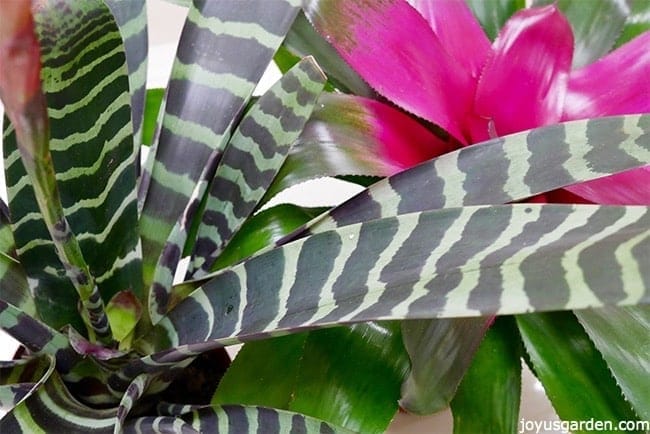
Here’s the Vriesea hanging out with a Neoregelia in my bathroom. You can clearly see the central cup which collects the water & nutrients.
Growing Mix
Vrieseas need to have excellent drainage because their roots don’t like to stay constantly wet. For this reason, orchid bark (small, medium or large) or cymbidium mix works just fine. I’ve also used a mixture of 1/2 orchid bark & 1/2 coco coir, which is an environmentally wiser alternative to peat moss.
Propagating/Repotting
Bromeliads don’t have an extensive root system so you probably won’t have to repot yours. The mother plant flowers only once and then eventually dies. Pups, or babies, are formed off the mother so a part of her actually lives on.
I find that the pups appear in the center of this bromeliad & not off the sides. You can leave them attached to the mother & cut away the flower stalk & foliage after they die or you can cut the pups off when they get to be a decent size, about 5 or 6″. Use a clean, sharp knife & get a piece of the roots. You can either pot them up or attach them to wood or driftwood.
Humidity/Temperature
As I always say, if your house is comfortable for you, it’ll be fine for your houseplants. Just avoid putting your Vriesea in any areas with hot or cold drafts, & not next to or on a heater or air conditioner.
Bromeliads grow in the sub tropics & the tropics but most seem to handle the lack of humidity in our homes & offices fine. I just want to let you know that this Flaming Sword, like the Guzmania, is susceptible to brown tipping (at the end of the leaves) which I point out in the video. That weekly misting or spraying will help this a bit.
Safe For Pets
The Vriesea, like other bromeliads, are reportedly non-toxic for both cats & dogs. They have crunchy leaves so if your kitty likes to chomp away, then best to keep Fluffy & the plant separated. It won’t poison but could cause an upset stomach.
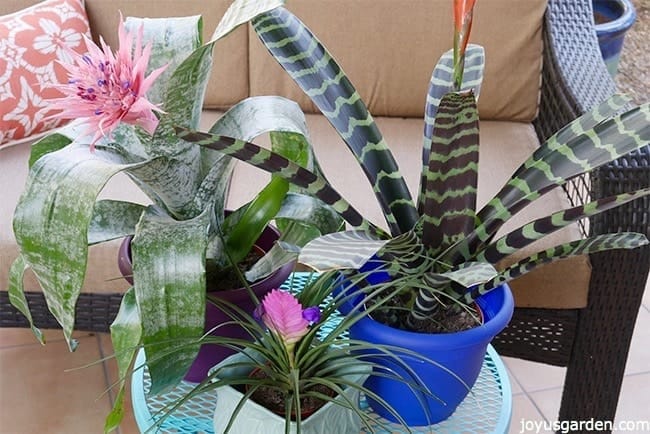
The Vriesea has jazzier foliage than it’s fellow bromeliads the Aechmea & Pink Quill Plant. It’s much more interesting (in my opinion anyway) after the flower dies.
Vrieseas make great houseplants and are not only easy to maintain but are very interesting and colorful too.
You should give the Vriesea a try. With it’s jazzy, animal print foliage and vibrant flower, you just can’t go wrong. What’s your favorite bromeliad?
Happy gardening & thanks for stopping by,

You may also enjoy:

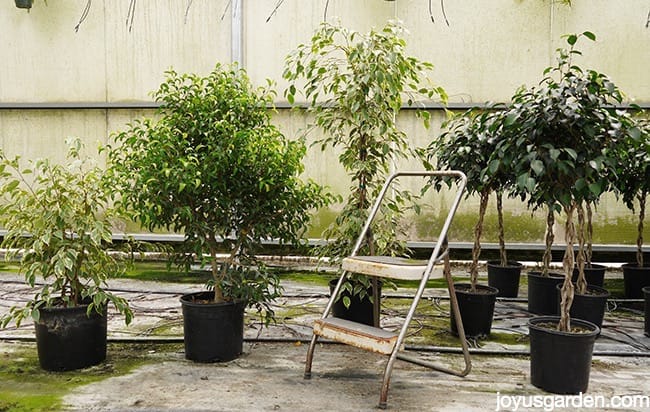
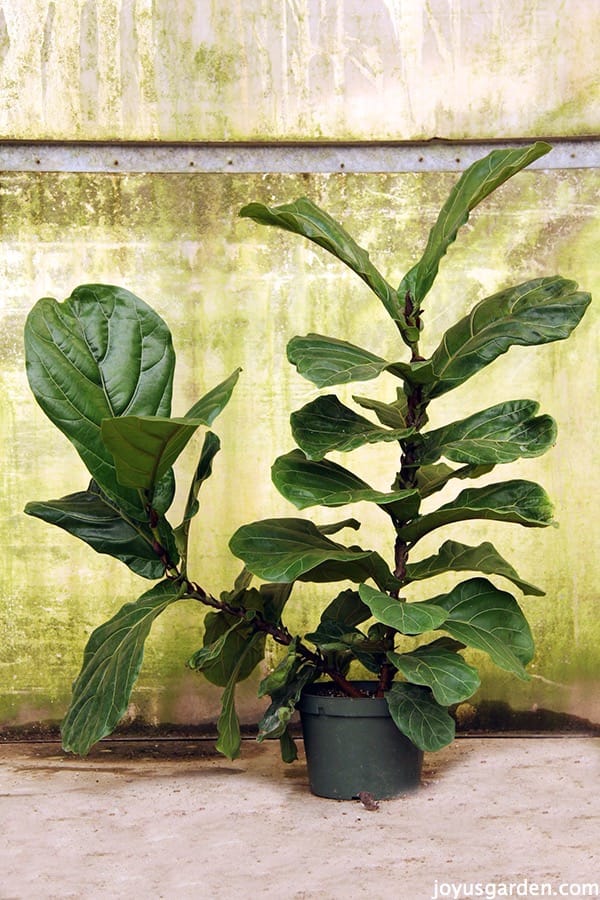
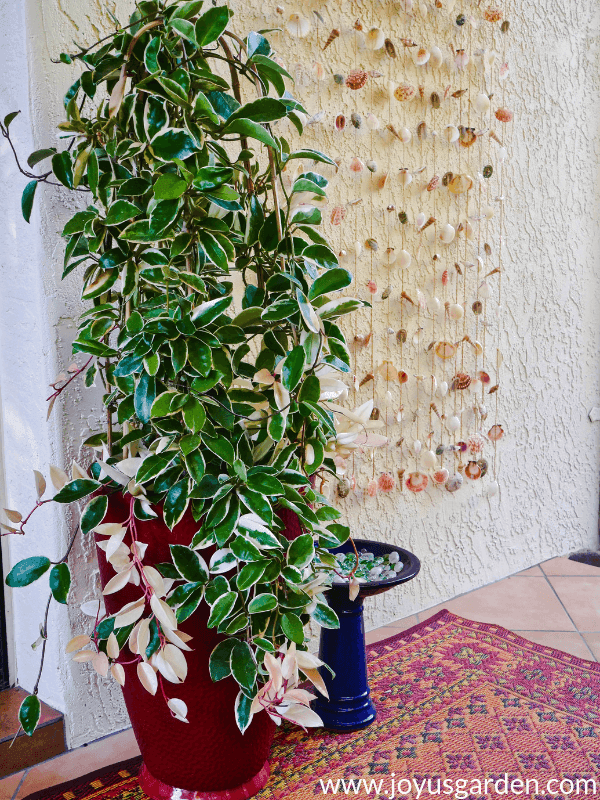
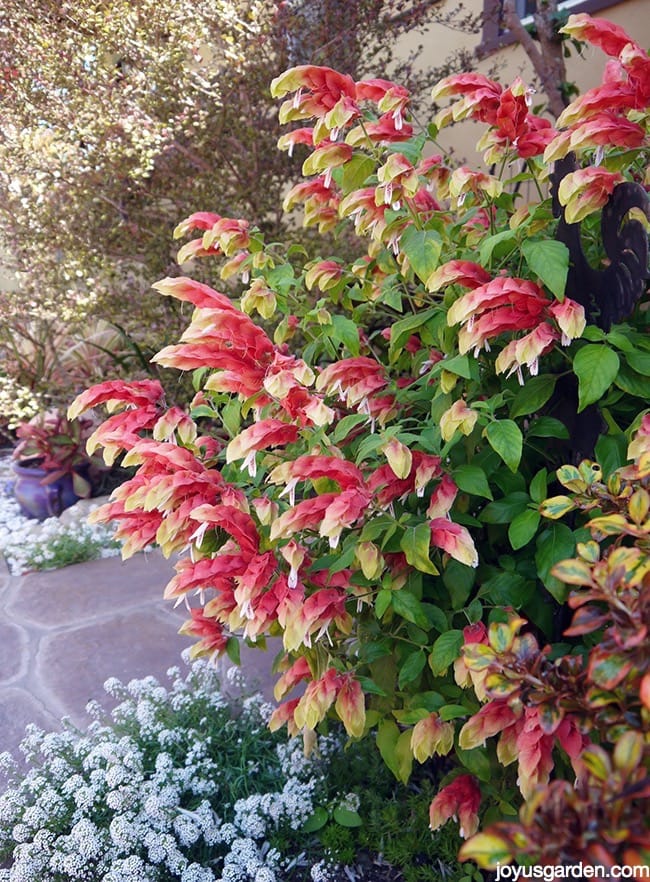

I have an issue with my “flaming sword” and I’m not sure if it’s over watered? But wondering if I can send a picture in and you can help?! I’m terrible at keeping plants alive. I usually just stick to cacti for that reason. 🙁
Hi Brittany – Bromeliads, in general, are epiphytes & like to be kept on the drier side. It also depends on what type of mix it’s growing in. Nell